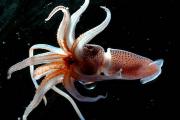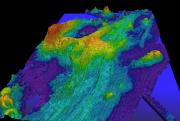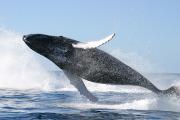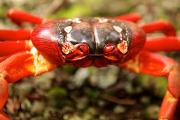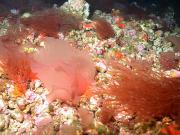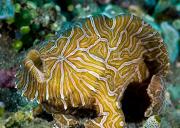Radio Program
Our regular Science and the SeaTM radio program presents marine science topics in an engaging two-minute story format. Our script writers gather ideas for the radio program from the University of Texas Marine Science Institute's researchers and from our very popular college class, Introduction to Oceanography, which we teach to hundreds of non-science majors at The University of Texas at Austin every year. Our radio programs are distributed at to commercial and public radio stations across the country.
A type of sea cucumber found south of the Philippines leaves nothing to the imagination. The pink sea-through fantasia has a completely transparent body. That reveals its entire digestive system, from top to bottom.
The fantasia was discovered in 2007 as part of the Census of Marine Life. This decade-long project sent 2700 researchers from 80 countries on more than 500 expeditions, to all the world’s oceans. The scientists used robotic submarines and other equipment to seek forms of life that no one had ever seen before.
Scientists have rules for naming everything from mushrooms to ice floes on Pluto. And that includes features on the bottom of the ocean: volcanoes, canyons, reefs, and many others.
For most of human history, naming features on the sea floor wasn’t a problem. With a few exceptions, the features were hidden from view. And that didn’t change in a major way until the invention of sonar in the last century, allowing scientists to discover thousands of features.
Whales are among the largest and most graceful animals on the planet. And they’re also among the most endangered. Although commercial whaling has been scaled back in recent decades, some countries still pursue these beautiful creatures.
When the rainy season arrives on Christmas Island, usually in late October or early November, one of the world’s most amazing migrations gets under way. Tens of millions of red crabs leave the rainforest and head for the rocky beaches, where they breed. A couple of weeks later, the females they lay their eggs in the ocean. The eggs hatch as soon as they hit the water, and the larvae float at sea for weeks before returning to the island -- if they aren’t eaten by the giant whale shark, which shows up during the migration season to snack on the little critters.
The batteries that power electric cars may someday have something in common with toothpaste and ice cream: their ingredients will be held together with a compound that comes from seaweed.
Lithium-sulfur batteries produce more energy than lithium-ion batteries, which are used in cars today. They also weigh less, and they’re less expensive. One problem, though, is that their sulfur quickly dissolves. So lithium-sulfur batteries aren’t a good choice for cars or other applications that require a long battery life.
Fish find lots of ways to get around: They swim, they crawl, they attach themselves to other organisms and go along for the ride. But the way a fish that was discovered a decade ago gets around, you might think it got a hold of some fermented kelp: It bounces off the ocean floor like a beach ball. Combined with its colorful appearance, that earned it the name Historiophryne psychedelica: the psychedelic frogfish.
Climate scientists are debating just how much global sea level will rise by the end of the 21st century. Projections range from less than a foot to more than six feet.
Another rapid rise in sea level took place about 8200 years ago. And the water might have come from a single source: a giant lake that stretched from present-day North Dakota and Minnesota through much of central Canada.
Thanks to El Niño, most of us know that there’s a connection between water temperatures in the Pacific Ocean and weather patterns in North America. Warmer water in the eastern Pacific produces more water vapor in the atmosphere, which produces more rain in parts of the United States.
Pacific temperatures may have a big impact in other places as well -- as far away as Antarctica. A study found that an increase in the amount of sea ice around Antarctica could be driven by conditions in the Pacific.
As its name might suggest, the lumpsucker isn’t the most attractive fish in the ocean. It’s shaped like a ball, and it has a “sucker” on its stomach that it uses to attach to rocks and kelp. Many species have lumpy, spiny skin. And they’re not great swimmers -- they lurch about with little control over where they’re going. Yet they may have a future in the cleaning business.
The northern coast of Australia looks like something is missing -- as though someone took a giant knife and carved out a square notch. But it wasn’t carved at all. Instead, it’s the result of flooding caused by rising sea levels after the last ice age.
The Gulf of Carpentaria covers about a hundred thousand square miles -- roughly the size of Colorado. At most, it’s about 250 feet deep, although most of it is much shallower.

